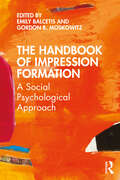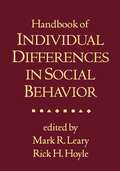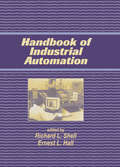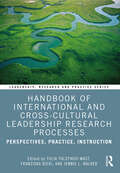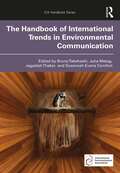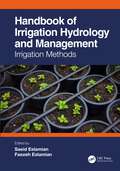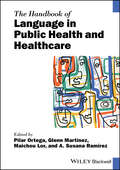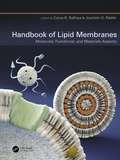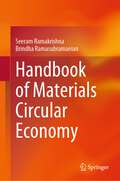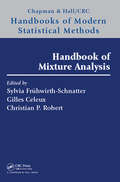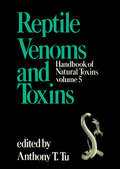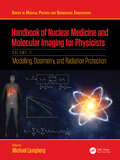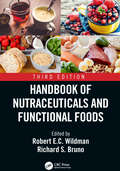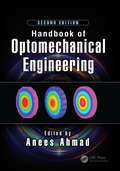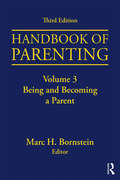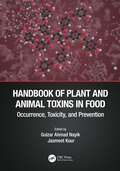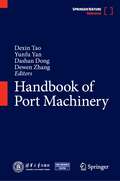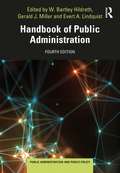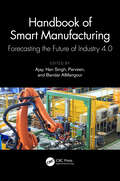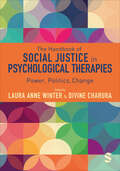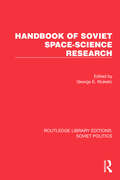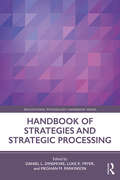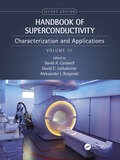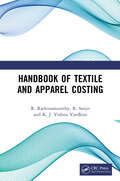- Table View
- List View
The Handbook of Impression Formation: A Social Psychological Approach
by Emily Balcetis Gordon B. MoskowitzPresenting diverse perspectives from eminent scholars and contemporary researchers, The Handbook of Impression Formation contextualizes current and future areas of research in the social psychology of impression formation within a rich historic framework. Affirming that impression formation is at the core of human experience, chapters explore how and why people form snap judgments about others and when those impressions update. They examine the processes through which people infer the reasons for the events they encounter, allowing people to plan for appropriate behavioral responses to social contexts. The research reviewed is informed by the foundational theory of unconscious automatic processes involved in making judgements of other people, pioneered by Professor Jim Uleman who contributes a chapter that suggests important new directions, and concludes the volume by reflecting on the state of the field more broadly. The book explores how certain attributes stimulate categorization, examining current issues around implicit bias, stereotypes, and social media. Chapters cover a range of approaches, featuring personal narratives, presentation of new data and discoveries, comprehensive literature reviews, and contemplations on where the field must go and what questions require focus for progress to be made, calling for even the most advanced scholars to contribute more to the collective investigation of impression formation.This fascinating work provides a solid foundation from which all researchers can build a new and unique program of research, and arms the reader with the intellectual tools they need to chart new theoretical territory and discover aspects of the human experience we have yet to even wonder about. It is essential reading for students and academics in social psychology, and the social sciences more broadly.
Handbook Of Individual Differences In Social Behavior
by Mark R. Leary Rick H. HoyleHow do individual differences interact with situational factors to shape social behavior? Are people with certain traits more likely to form lasting marriages; experience test-taking anxiety; break the law; feel optimistic about the future? This handbook provides a comprehensive, authoritative examination of the full range of personality variables associated with interpersonal judgment, behavior, and emotion. The contributors are acknowledged experts who have conducted influential research on the constructs they address. Chapters discuss how each personality attribute is conceptualized and assessed, review the strengths and limitations of available measures (including child and adolescent measures, when available), present important findings related to social behavior, and identify directions for future study.
Handbook Of Industrial Automation
by Richard ShellSupplies the most essential concepts and methods necessary to capitalize on the innovations of industrial automation, including mathematical fundamentals, ergonometrics, industrial robotics, government safety regulations, and economic analyses.
Handbook of International and Cross-Cultural Leadership Research Processes: Perspectives, Practice, Instruction (ISSN)
by Yulia Tolstikov-MastAn invaluable contribution to the area of leadership studies, the Handbook of International and Cross-Cultural Leadership Research Processes: Perspectives, Practice, Instruction brings together renowned authors with diverse cultural, academic, and practitioner backgrounds to provide a comprehensive overview and analysis of all stages of the research process.The handbook centers around authors’ international research reflections and experiences, with chapters that reflect and analyze various research experiences in order to help readers learn about the integrity of each stage of the international leadership research process with examples and discussions. Part I introduces philosophical traditions of the leadership field and discusses how established leadership and followership theories and approaches sometimes fail to capture leadership realities of different cultures and societies. Part II focuses on methodological challenges and opportunities. Scholars share insights on their research practices in different stages of international and cross-cultural studies. Part III is forward-looking in preparing readers to respond to complex realities of the leadership field: teaching, learning, publishing, and applying international and cross-cultural leadership research standards with integrity. The unifying thread amongst all the chapters is a shared intent to build knowledge of diverse and evolving leadership practices and phenomena across cultures and societies.The handbook is an excellent resource for a broad audience including scholars across disciplines and fields, such as psychology, management, history, cognitive science, economics, anthropology, sociology, and medicine, as well as educators, consultants, and graduate and doctoral students who are interested in understanding authentic leadership practices outside of the traditional Western paradigm.
The Handbook of International Trends in Environmental Communication (ICA Handbook Series)
by Bruno TakahashiThis handbook provides a comprehensive review of communication around rising global environmental challenges and public action to manage them now and into the future. Bringing together theoretical, methodological, and practical chapters, this book presents a unique opportunity for environmental communication scholars to critically reflect on the past, examine present trends, and start envisioning exciting new methodologies, theories, and areas of research. Chapters feature authors from a wide range of countries to critically review the genesis and evolution of environmental communication research and thus analyze current issues in the field from a truly international perspective, incorporating diverse epistemological perspectives, exciting new methodologies, and interdisciplinary theoretical frameworks. The handbook seeks to challenge existing dominant perspectives of environmental communication from and about populations in the Global South and disenfranchised populations in the Global North.The Handbook of International Trends in Environmental Communication is ideal for scholars and advanced students of communication, sustainability, strategic communication, media, environmental studies, and politics.
Handbook of Irrigation Hydrology and Management: Irrigation Methods
by Saeid Eslamian Faezeh EslamianEver-increasing population growth has caused a proportional increased demand for water, and existing water sources are depleting day by day. Moreover, with the impact of climate change, the rates of rainfall in many regions have experienced a higher degree of variability. In many cities, government utilities have been struggling to maintain sufficient water for the residents and other users. The Handbook of Irrigation Hydrology and Management: Irrigation Methods examines and analyzes irrigated ecosystems in which water storage, applications, or drainage volumes are artificially controlled in the landscape and the spatial domain of processes varies from micrometers to tens of kilometers, while the temporal domain spans from seconds to centuries. The continuum science of irrigation hydrology includes the surface, subsurface (unsaturated and groundwater systems), atmospheric, and plant subsystems. Further, the book addresses the best practices for various types of irrigation methods including pressure, smart, surface, and subsurface, and presents solutions for water scarcity and soil salinity in irrigation.Features: Offers water-saving strategies to increase the judicious use of scarce water resources Presents strategies to maximize agricultural yield per unit of water used for different regions Compares irrigation methods to offset changing weather patterns and impacts of climate change
The Handbook of Language in Public Health and Healthcare (Blackwell Handbooks in Linguistics)
by Pilar Ortega Glenn Martínez Maichou Lor A. Susana RamírezAn interdisciplinary overview of theory, history, and leading research in the field With a joint linguistic and medical perspective, The Handbook of Language in Public Health and Healthcare explores innovative approaches for improving clinical education, clinician-patient communication, assessment, and mass communication. Contributions by a diverse panel of experts address a wide range of key topics, including language concordance in clinical care, medical interpreting, the role of language as a social determinant of health, reaching linguistically diverse audiences during public health crises, assessing clinician language skills, and more. Organized into five parts, the Handbook covers the theory, history, and context of linguistics, language interpretation and translation, language concordance, medical language education pedagogy, and mass communication of health information with linguistically diverse populations. Throughout the text, detailed chapters present solutions and strategies with the potential to improve the health and healthcare of linguistically diverse populations worldwide. In an increasingly multilingual, global society, language has become a critical area of interest for advancing public health and healthcare. The Handbook of Language in Public Health and Healthcare: Helps professionals integrate language-appropriate communication in healthcare settings Addresses clinician-patient communication, assessment, research, and mass public health communication Offers key theoretical insights that inform the intersection of language, public health, and healthcare Highlights how various approaches in the field of linguistics have enriched public health and healthcare practices The Handbook of Language in Public Health and Healthcare is essential reading for undergraduate, postgraduate, and professional students of applied linguistics, health communication, and medicine. It is also an invaluable reference for language educators, clinicians, medical educators, linguists, health policy experts, and researchers.
Handbook of Lipid Membranes: Molecular, Functional, and Materials Aspects
by Cyrus R. Safinya Joachim O. RädlerThis handbook provides a unique overview of lipid membrane fundamentals and applications. The fascinating world of lipids that harbor and govern so many biological functionalities are discussed within the context of membrane structures, interactions, and shape evolution. Beyond the fundamentals in lipid science, this handbook focuses on how scientists are building bioinspired biomimetic systems for applications in medicine, cosmetics, and nanotechnology. Key Features: Includes experimental and theoretical overviews on the role of lipids, with or without associated biomolecules, as structural components imparting distinct membrane shapes and intermembrane interactions Covers the mechanisms of lipid-membrane curvature, by peptide and protein binding, and the roles of signalling lipids and the cytoskeleton in plasma membrane shape evolution Covers advanced X-ray and force measurement techniques Discusses applications in biomedicine, cosmetics, and nanotechnology, including lipid vectors in nucleic acid, drug delivery in dermal applications, and lipid-based sensors and artificial biointerfaces Covers artificial membranes from block copolymers, synthetic copolypeptides, and recombinant proteins Includes an exciting section that explores the role of lipids in the origin of life in hydrothermal conditions This book is a highly informative companion for professionals in biophysics, biochemistry, physical chemistry, and material and pharmaceutical sciences and bioengineering.
Handbook of Materials Circular Economy
by Seeram Ramakrishna Brindha RamasubramanianThis book provides comprehensive and practical information on the design and implementation of circular systems for various industries, with a focus on Environmental, Social, and Governance (ESG) factors. The scope of the handbook is to cover the materials circularity in a deeper analysis in accordance to ESG used in various industries such as oil and gas, IT, electronics, medicine, textile, and more. The handbook also covers the key principles of the circular economy, including material efficiency, resource conservation, and waste reduction, and how they impact to different industries. It further critically analyses the challenges and opportunities associated with implementing circular systems in these industries, including the framework for new business models and technical innovations, and the potential benefits in terms of environmental protection, social responsibility, and economic competitiveness. In addition to providing practical information, the handbookalso addresses the ESG factors associated with the circular economy exclusively for each industry. This would include the impact of circular systems on the environment, including the reduction of greenhouse gas emissions and the protection of biodiversity, as well as the social benefits, such as job creation, and the economic benefits, such as cost savings and increased competitiveness. The ultimate goal of the handbook should be to provide guidance and support in a niche evaluation for the development of a more sustainable and equitable future, where the circular economy is a key enabler.
Handbook of Mixture Analysis (ISSN)
by Sylvia Frühwirth-Schnatter, Gilles Celeux and Christian P. RobertMixture models have been around for over 150 years, and they are found in many branches of statistical modelling, as a versatile and multifaceted tool. They can be applied to a wide range of data: univariate or multivariate, continuous or categorical, cross-sectional, time series, networks, and much more. Mixture analysis is a very active research topic in statistics and machine learning, with new developments in methodology and applications taking place all the time. The Handbook of Mixture Analysis is a very timely publication, presenting a broad overview of the methods and applications of this important field of research. It covers a wide array of topics, including the EM algorithm, Bayesian mixture models, model-based clustering, high-dimensional data, hidden Markov models, and applications in finance, genomics, and astronomy.Features: Provides a comprehensive overview of the methods and applications of mixture modelling and analysis Divided into three parts: Foundations and Methods; Mixture Modelling and Extensions; and Selected Applications Contains many worked examples using real data, together with computational implementation, to illustrate the methods described Includes contributions from the leading researchers in the field The Handbook of Mixture Analysis is targeted at graduate students and young researchers new to the field. It will also be an important reference for anyone working in this field, whether they are developing new methodology, or applying the models to real scientific problems.
Handbook of Natural Toxins: Reptile Venoms and Toxins (Handbook Of Natural Toxins Ser.)
by Anthony T. TuIn 24 contributed chapters, 37 international specialists describe the latest developments in research on snake venom including different types of venoms and toxins, actions, antidotes, and applications and summarize what is known to date on Gila monster and frog toxins. Some 70 tables provide essent
Handbook of Nuclear Medicine and Molecular Imaging for Physicists: Modelling, Dosimetry and Radiation Protection, Volume II (ISSN)
by Michael LjungbergMathematical modelling is an important part of nuclear medicine. Therefore, several chapters of this book have been dedicated towards describing this topic. In these chapters, an emphasis has been put on describing the mathematical modelling of the radiation transport of photons and electrons, as well as on the transportation of radiopharmaceuticals between different organs and compartments. It also includes computer models of patient dosimetry. Two chapters of this book are devoted towards introducing the concept of biostatistics and radiobiology. These chapters are followed by chapters detailing dosimetry procedures commonly used in the context of diagnostic imaging, as well as patient-specific dosimetry for radiotherapy treatments. For safety reasons, many of the methods used in nuclear medicine and molecular imaging are tightly regulated. Therefore, this volume also highlights the basic principles for radiation protection. It discusses the process of how guidelines and regulations aimed at minimizing radiation exposure are determined and implemented by international organisations. Finally, this book describes how different dosimetry methods may be utilized depending on the intended target, including whole-body or organ-specific imaging, as well as small-scale to cellular dosimetry.This text will be an invaluable resource for libraries, institutions, and clinical and academic medical physicists searching for a complete account of what defines nuclear medicine. The most comprehensive reference available providing a state-of-the-art overview of the field of nuclear medicine Edited by a leader in the field, with contributions from a team of experienced medical physicists, chemists, engineers, scientists, and clinical medical personnel Includes the latest practical research in the field, in addition to explaining fundamental theory and the field's history
Handbook of Nutraceuticals and Functional Foods
by Robert E.C. Wildman and Richard S. BrunoThe field of functional foods along with their bioactive food components has grown tremendously over the past decades. Often guided by hypothesis-generating epidemiological observations, discoveries from basic science studies and controlled trials in humans have provided critical evidence to help establish an optimal diet that alleviates chronic disease risk. These advances have also driven efforts by the food and nutraceutical industries to establish and market health claims, formulate extra-value foods, and even generate new health foods for human benefit.Handbook of Nutraceuticals and Functional Foods, Third Edition, compiles the data from experts in the field that potentiates the already established credibility of the earlier editions. In its three-section format, it provides an authoritative summary of the prophylactic and/or medicinal benefits of natural foods and their constituents that are linked to favorable health outcomes. Beginning with an overview of the field and associated regulations, each chapter describes the chemical properties, bioactivities, dietary sources, and evidence of these health-promoting dietary constituents.Features:• Summarizes plant- and animal-based functional foods and their bioactive components• New chapters on cannabidiol and scientific, legal, and regulatory considerations; green tea and nutraceutical applications; and herbal nutraceuticals and insulin resistance• Includes information on functional food beverages including coffee, green tea, and dairy milk• Discusses antioxidant and anti-inflammatory activities of vitamin E, anthocyanins and other (poly)phenolic compounds, and carotenoids• Provides an update on the health benefits and requirements of protein and performance and therapeutic application and safety of creatine.
Handbook of Optomechanical Engineering (Optical Sciences and Applications of Light)
by Anees AhmadThis comprehensive handbook covers all major aspects of optomechanical engineering - from conceptual design to fabrication and integration of complex optical systems. The practical information within is ideal for optical and optomechanical engineers and scientists involved in the design, development and integration of modern optical systems for commercial, space, and military applications. Charts, tables, figures, and photos augment this already impressive text. Fully revised, the new edition includes 4 new chapters: Plastic optics, Optomechanical tolerancing and error budgets, Analysis and design of flexures, and Optomechanical constraint equations.
Handbook of Parenting: Volume 3: Being and Becoming a Parent, Third Edition
by Marc H. BornsteinThis highly anticipated third edition of the Handbook of Parenting brings together an array of field-leading experts who have worked in different ways toward understanding the many diverse aspects of parenting. Contributors to the Handbook look to the most recent research and thinking to shed light on topics every parent, professional, and policymaker wonders about. Parenting is a perennially "hot" topic. After all, everyone who has ever lived has been parented, and the vast majority of people become parents themselves. No wonder bookstores house shelves of "how-to" parenting books, and magazine racks in pharmacies and airports overflow with periodicals that feature parenting advice. However, almost none of these is evidence-based. The Handbook of Parenting is. Period. Each chapter has been written to be read and absorbed in a single sitting, and includes historical considerations of the topic, a discussion of central issues and theory, a review of classical and modern research, and forecasts of future directions of theory and research. Together, the five volumes in the Handbook cover Children and Parenting, the Biology and Ecology of Parenting, Being and Becoming a Parent, Social Conditions and Applied Parenting, and the Practice of Parenting.Volume 3, Being and Becoming a Parent, considers a large cast of characters responsible for parenting, each with her or his own customs and agenda, and examines what the psychological characteristics and social interests of those individuals reveal about what parenting is. Chapters in Part I, on The Parent, show just how rich and multifaceted is the constellation of children’s caregivers. Considered first are family systems and then successively mothers and fathers, coparenting and gatekeeping between parents, adolescent parenting, grandparenting, and single parenthood, divorced and remarried parenting, lesbian and gay parents and, finally, sibling caregivers and nonparental caregiving. Parenting also draws on transient and enduring physical, personality, and intellectual characteristics of the individual. The chapters in Part II, on Becoming and Being a Parent, consider the intergenerational transmission of parenting, parenting and contemporary reproductive technologies, the transition to parenthood, and stages of parental development, and then chapters turn to parents' well-being, emotions, self-efficacy, cognitions, and attributions as well as socialization, personality in parenting, and psychoanalytic theory. These features of parents serve many functions: they generate and shape parental practices, mediate the effectiveness of parenting, and help to organize parenting.
Handbook of Plant and Animal Toxins in Food: Occurrence, Toxicity, and Prevention
by Gulzar Ahmad Nayik and Jasmeet KourThe prevalence of naturally occurring toxins in plant and animal foods represents one of the most significant food safety issues, drawing the attention of both scientists and regulators alike. This unexplored area related to food quality is indeed a big concern for consumers, various regulatory authorities, and food industries. Apart from essential nutrients, several food crops are capable of producing a vast array of nonnutritious secondary metabolic products. These toxins produced as secondary metabolites have the potential to exhibit both beneficial and deleterious effects in both human beings and animals. Nevertheless, there has been huge progress in agricultural practices and food processing technologies, but still the number of nonnutritive substances and naturally derived toxins persist in our diet. Handbook of Plant and Animal Toxins in Food: Occurrence, Toxicity, and Prevention, focuses on various selected toxins in foods derived from plants as well as animals. The prominent plant toxins include solanine and chaconine, mushroom toxins, phytates, tannins, oxalates, goitrogens, gossypol, phytohemagglutinins, erucic acid, saponins, cyanogenic glycosides, enzyme inhibitors, BOAA (lathyrogens), toxic amino acids and toxic fatty acids. The prominent animal toxins covered in the book include various seafood toxins, shellfish toxins and biogenic amines. Key Features: Presents complete information about a plethora of toxins Provides quick and easy access to data on major plant and animal toxins Covers distribution of toxins in the plant and animal kingdom Provides comprehensive information on chemistry, safety and precautions of each toxin Commencing with a brief introduction of food toxins, this book is designed in such a way that the readers will be introduced to toxicity, safety and occurrence of each toxin selected. It also discusses the in-depth detailed information on food poisoning and its prevention. The book will also shed light on foodborne illness associated with toxins. The primary audience for this work will be food scientists, food toxicologists, university scholars and college students. Furthermore, the book will be of immense help for public health officials, pharmacologists, and food safety officers who are involved with enforcing regulations meant to ensure the safety of a particular food
Handbook of Port Machinery
by Dexin Tao Yunfu Yan Dashan Dong Dewen ZhangThe CCMS Handbook of Port Machinery is an extensive reference guide intended to meet the needs of port handling machinery users and port planning and design institutes with regard to equipment selection, equipment application, and maintenance management. It comprehensively and systematically introduces readers to the characteristics, classification, structure, working principles, main technical performance parameters, corresponding technical standards, and matters requiring special attention in equipment selection for typical port handling machinery. The handbook supplements relevant handbooks on port machinery product design specifications, and provides essential technical guidance to help users fully understand and correctly select port machinery and equipment. At the same time, it offers a valuable resource for technical personnel, university teachers and students who are engaged in port planning and design, handling process design, port machinery product design, portmachinery use and maintenance. A comprehensive guide to port handling machinery, it reflects the current state of development and application status of port machinery in China.
Handbook of Public Administration: Theory, Politics, And Methods (Public Administration and Public Policy #1)
by W. Bartley Hildreth Gerald J. Miller Evert A. LindquistPublic administration as a field of study finds itself in the middle of a fluid environment. The very reach and complexity of public administration has been easy to take for granted, easy to attack, and difficult to explain, particularly in the soundbite and Twitter-snipe media environment. Not only has the context for the discipline changed, but the institutions of public administration have adapted and innovated to deliver services to the public and serve those in power while becoming increasingly complex themselves. Has public administration evolved? And what new lines of research are critical for effective policy and delivery of programs and public services while preserving foundational principles such as the rule of law and expert institutions? This Handbook of Public Administration sheds light for new researchers, doctoral students, scholars, and practitioners interested in probing modern public administration’s role in solving major challenges facing nations and the world. This fourth edition recognizes that the scholarship of public administration must reflect the diverse influence of an international orientation, embracing public administration issues and practices in governance systems around the world, and illustrating just how practice can vary across jurisdictions. Every section identifies foundational principles and issues, shows variation in practice across selected jurisdictions, and identifies promising avenues for research. Each chapter revisits enduring themes and tensions, showing how they persist, along with new challenges and opportunities presented by digital technology and contemporary political realities. The Handbook of Public Administration, Fourth Edition provides a compelling introduction to and depiction of the contemporary realities of public administration, and it will inspire new avenues of inquiry for the next generation of public administration researchers.
Handbook of Smart Manufacturing: Forecasting the Future of Industry 4.0
by Ajay Hari Singh Parveen Bandar AlMangourThis handbook covers smart manufacturing development, processing, modifications, and applications. It provides a complete understanding of the recent advancements in smart manufacturing through its various enabling manufacturing technologies, and how industries and organizations can find the needed information on how to implement smart manufacturing towards sustainability of manufacturing practices.Handbook of Smart Manufacturing: Forecasting the Future of Industry 4.0 covers all related advances in manufacturing such as the integration of reverse engineering with smart manufacturing, industrial internet of things (IIoT), and artificial intelligence approaches, including Artificial Neural Network, Markov Decision Process, and Heuristics Methodology. It offers smart manufacturing methods like 4D printing, micro-manufacturing, and processing of smart materials to assist the biomedical industries in the fabrication of human prostheses and implants. The handbook goes on to discuss how to accurately predict the requirements, identify errors, and make innovation for the manufacturing process more manageable by implementing various advanced technologies and solutions into the traditional manufacturing process. Strategies and algorithms used to incorporate smart manufacturing into different sectors are also highlighted within the handbook.This handbook is an invaluable resource for stakeholders, industries, professionals, technocrats, academics, research scholars, senior graduate students, and human healthcare professionals.
The Handbook of Social Justice in Psychological Therapies: Power, Politics, Change
by Laura Anne Winter Divine CharuraAre you looking for a psychological therapy textbook with social justice at its centre? Just can′t seem to find a comprehensive textbook that aligns with your attitudes toward positive changes in psychological professions? This three-part book sets out the core principles for social justice in the psychological therapies. In Part 1 you′ll be introduced to Social Justice Theory in the psychological therapies, covering identity and intersectionality and integrating the psychological and socio-political. In Part 2, you can expand on your knowledge with Social Justice informed therapeutic practice, which looks at the ways in which social class, race, disability, and other minoritised identities can inform therapeutic practice. In Part 3, you will look Beyond the therapy room, and explore how to apply your social justice knowledge to clinical supervision, community psychology and other non-traditional therapeutic models. Supported by a wealth of features including reflective and critical thinking questions, case studies, and recommended further reading resources, this book will help equip you with the knowledge, skills and attitude to work as a more socially conscientious practitioner.
The Handbook of Social Justice in Psychological Therapies: Power, Politics, Change
by Laura Anne Winter Divine CharuraAre you looking for a psychological therapy textbook with social justice at its centre? Just can′t seem to find a comprehensive textbook that aligns with your attitudes toward positive changes in psychological professions? This three-part book sets out the core principles for social justice in the psychological therapies. In Part 1 you′ll be introduced to Social Justice Theory in the psychological therapies, covering identity and intersectionality and integrating the psychological and socio-political. In Part 2, you can expand on your knowledge with Social Justice informed therapeutic practice, which looks at the ways in which social class, race, disability, and other minoritised identities can inform therapeutic practice. In Part 3, you will look Beyond the therapy room, and explore how to apply your social justice knowledge to clinical supervision, community psychology and other non-traditional therapeutic models. Supported by a wealth of features including reflective and critical thinking questions, case studies, and recommended further reading resources, this book will help equip you with the knowledge, skills and attitude to work as a more socially conscientious practitioner.
Handbook of Soviet Space-Science Research (Routledge Library Editions: Soviet Politics)
by George E. WukelicHandbook of Soviet Space-Science Research (1968) provides a comprehensive and authoritative English language summary of Soviet space-science research of the 1960s.
Handbook of Strategies and Strategic Processing (Educational Psychology Handbook)
by Daniel L. Dinsmore, Luke K. Fryer, Meghan M. ParkinsonHandbook of Strategies and Strategic Processing provides a state-of-the-art synthesis of conceptual, measurement, and analytical issues regarding learning strategies and strategic processing. Contributions by educational psychology experts present the clearest-yet definition of this essential and quickly evolving component of numerous theoretical frameworks that operate across academic domains. This volume addresses the most current research and theory on the nature of strategies and performance, mechanisms for unearthing individuals’ strategic behaviors, and both long-established and emerging techniques for data analysis and interpretation.
Handbook of Superconductivity: Characterization and Applications, Volume Three
by David A. Cardwell David C. Larbalestier Aleksander I. BraginskiThis is the last of three volumes of the extensively revised and updated second edition of the Handbook of Superconductivity. The past twenty years have seen rapid progress in superconducting materials, which exhibit one of the most remarkable physical states of matter ever to be discovered. Superconductivity brings quantum mechanics to the scale of the everyday world. Viable applications of superconductors rely fundamentally on an understanding of these intriguing phenomena and the availability of a range of materials with bespoke properties to meet practical needs.While the first volume covers fundamentals and various classes of materials, the second addresses processing of these into various shapes and configurations needed for applications, and ends with chapters on refrigeration methods necessary to attain the superconducting state and the desired performance. This third volume starts with a wide range of methods permitting one to characterize both the materials and various end products of processing. Subsequently, diverse classes of both large scale and electronic applications are described. Volume 3 ends with a glossary relevant to all three volumes. Key Features: Covers the depth and breadth of the field Includes contributions from leading academics and industry professionals across the world Provides hands-on familiarity with the characterization methods and offers descriptions of representative examples of practical applications A comprehensive reference, the handbook is suitable for both graduate students and practitioners in experimental physics, materials science, and multiple engineering disciplines, including electronic and electrical, chemical, mechanical, metallurgy and others.
Handbook of Textile and Apparel Costing
by R. Rathinamoorthy R. Surjit K. J. VardhiniHandbook of Textile and Apparel Costing covers a wider area of the costing aspects of industrial and academic requirements from spinning to the apparel sector.It is a one of its kind in the textile and fashion discipline that covers the cost calculation methods of every manufacturing step in entirety: spinning, weaving, processing, and apparel manufacturing.Print edition not for sale in South Asia (Bangladesh, Bhutan, India, Nepal, Pakistan and Sri Lanka)
